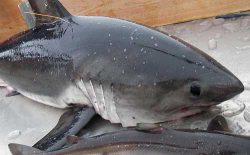select your film:


The Salmon Shark is a coastal shark found in both nearshore and oceanic environments. They are commonly from near the surface to at least 152m deep. These sharks live in northern regions that have cool temperate waters, ranging from 5-18°C. They are native to the north and the central Pacific Ocean and are common in Canada, The United States, the Gulf of Alaska, Sea of Japan, as well as the California Current.
Biology:
Salmon Sharks have stocky bodies and a cone-shaped snout. They have relatively long gills and a broad and rounded mouth containing around 55 moderately large, blade-like teeth. Each tooth has two small hook-like teeth on each side called cusplets. They have a large first and much smaller second dorsal fin (top fin), a small bottom fin and a crescent-shaped fin in the tail. They’re commonly found alone or in schools and feeding clusters up to 30 to 40 sharks. Males are commonly estimated to reach sexual maturity at approximately 140 cm and females between 175 cm. Salmon Sharks have a typical lifespan of 20 to 30 years. The max length of a Salmon Shark is 305 cm while the common length is 180cm. They can also weigh upwards of 220 kg. The Salmon Shark is one of only five shark species that is endothermic which mean they have warm blood. Their body temperatures can exceed water temperatures by as much as 21.2°C.
Reproduction:
Salmon shark eggs hatch within the body of the mother shark, with up to 4 young in a litter. The hatched young feeds on unhatched and unfertilized eggs.
Behaviour:
They are fast swimmers and are potentially dangerous but have rarely attacked humans, although damage to commercial gear has been reported. They eat smaller fish like mackerel, daggertooth fish, and salmon. Salmon sharks are season migrators and suspected to follow the movement of preferred prey, for instance, the western North Pacific population follows herring and sardines and the eastern North Pacific populations follows Pacific salmon species.
A remarkable sex ratio difference occurs in Salmon Sharks across the North Pacific areas. The male sharks dominate the western side and the eastern side is female dominated. Larger sharks range farther north than smaller individuals, with dominance increasing with latitude and southern catches generally occur in deeper waters.
Salmon Shark population appears to be stable.
Do you have images or videos of Salmon Sharks?
Submit them to [email protected].
